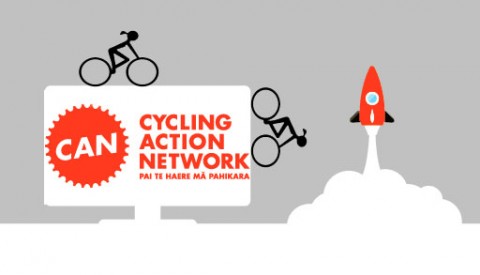
The Government is not moving fast enough to protect New Zealanders say advocates, following a third fatal crash involving a truck and a cyclist in a month.
Five of the last 7 cyclist fatalities involved a truck.
“It’s been two and half years since the Cycling Safety Panel recommended 15 high priority actions to make our roads safer,” says Patrick Morgan, spokesman for Cycling Action Network (CAN).
“Action has been too slow. It is clear how to make our roads safer, so why are we waiting? How many more people will die?”
The Cycling Safety Panel recommended, among other things:
• Investigate the costs and benefits of introducing mandatory truck side-under-run protection and other vehicle safety features (such as better mirrors, sensors and cameras).
• Design intersections so they are safe for cyclists. Trial European design guidelines for roundabouts and other innovative treatments.
• Increase and incentivise training for commercial drivers about driving safely near cyclists.
Raise cyclist awareness of the risks of riding near heavy vehicles.
“After more than two years, nothing has come out of the recommendation to investigate truck safety features,” says Mr Morgan.
“There are proven features that should be adopted as a requirement on trucks. Specifically, more effective mirrors, sensors, cameras and side under-run protection.”
“Intersection design and a lack of road shoulders are factors in some fatalities – known black spots – and should be addressed as a priority by Councils.”
CAN runs a Share the Road programme, which educates truck drivers and cyclists to be more aware of each other and adopt safer behaviours.
Share the Road is funded by NZTA and shows positive results. It has engaged with around 3,500 people over the past 5 years. However the programme reaches only a small proportion of truck drivers.
“We are only ever going to touch a small percentage of drivers until we are involved in the national driver training qualification system,” says Mr Morgan.
The recent deaths occurred near Tekapo on 15 March, in Hamilton on 5 April, and at Pakowhai in Hawkes Bay on 6 April.
“We are all mourning these unnecessary deaths.”





I only cycle in Otautahi but I can think of some more things that would help.
* A 30 km/hour limit in streets that are mainly residential, close to schools parks and other places where there are many children, and close to shopping centres
*A strict law on overtaking distances for motorist overtaking cyclists, eg 1 meter below 45 k/h and 1.5 meters above that
*A strict statement and enforcement of laws relating to cyclist and pedestrians such as drivers needing to take responsibility for controlling their dangerous vehicles.
That last one could include giving way to pedestrians and cyclist when turning at intersections, a clear statement that the drive must avoid collision with pedestrians and cyclist. If I use a gun or a chain saw and injure some one I can’t claim it was their fault they should not have been there, I must make sure they are not there before I perform any action that may hurt them. The same should apply to that dangerous tool, the motor vehicle.
It is varfy simple really, cyclist groups have been behind the taking of rail routes for cycle ways now.
Latest one is Gisborne to Wairoa rail now with Government support are taking it for a “bike trail”.
We who are trying desperately to save our rail to use for its intended purpose; – to remove trucks from use roads.
Please support our call to keep rail for freight and passenger services not exclusively for cycle trails please, then we will see our roads far less cluttered with killer heavy trucks and see far less cyclists killed under trucks.
Here are two of our press comments on this issue.
“Wrong way Kiwirail.” 30th March 2017.
Kiwi rail’s sudden announcement that it has made a decision to give access to a rail bike venture today 30/317 shutting out Gisborne from any freight and passenger/tourism access requires scrutiny firstly, since it appears rushed without notifying other interest bids.
Kiwirail makes a blunder by refusing to engage with all Maori, and the community groups ahead of the decision to decide to give our rail access to a “rail bike venture”.
On reflection Kiwirail in 2013/14 treated the HBRC very badly when it refused to offer that large powerful Council more than three months over that Xmas to provide a solid business plan.
HBRC has never recovered from that crushing treatment as they had an airtight backing for a complete rail services and funds to maintain the line also and their was an interest from HBRC to work with other parties to allow other uses as a bike trails and other ventures to enhance the whole region, without sacrificing anyone’s interest here.
This seemed the best decision Kiwirail could have made then and made money for the taxpayer to..
Now we find that after three years later Kiwirail held every other interested party in the compete dark, and refused any consultation with any of these parties except the Rail bike interested party any consideration we can draw a reasonable conclusion that this was kiwi rail’s plan all the time to not even consider any rail services at all and we need to have this lack of consideration for the community affected by their callous decision to ignore repeated requests from community groups and Maori for proper consultation given ahead of any decision.
Kiwirail have breached their own State Owned Enterprise Act obligations to engage with the community in which they operate and consider what is in their best interest here, never mind not even considering consulting with the land owners who allowed the rail line access across their tribal land years ago!
I am not a lawyer but Kiwirail have in my mind have blundered and made the wrong move right here.
Much dissention will be generated by ignoring the will of the people over what appears an easier way out for Kiwirail to remove itself from being responsible for providing a urgently needed rail freight and passenger/tourism service to the most isolated regional city/community in the country when we just witnessed Kiwirail restore two south Island rail routs in a heartbeat.
As the article in the Gisborne herald August 23, 2016 entitled “Labour-Greens united on rail” said ‘Wrong government in place’ to make rail a reality” we now see clear evidence of this so election time we need to rid the rail hating politics for our own good.
In the coming weeks we will see a backlash to this blunder by Kiwirail under the direction of a rail hating government.
It should be clear that none of the other bidders for the rail at this time were even given any discussion or consultation ahead of today’s decision, a bad act of good faith from Kiwirail to our community. Dark forces are emerging here.
I never had a call or any communication at all from Kiwirail though we had offered to assist Kiwirail in Environmental monitoring issues for free.?
Member of the Gisborne rail Co-operative.
August 23, 2016
gisborneherald.co.nz
Labour-Greens united on rail
Published: August 23, 2016 11:17AM
‘Wrong government in place’ to make rail a reality: Labour and Greens.
THE Labour and Green parties last night committed to re-opening the entire length of the Gisborne to Napier rail line but pointed out that would only happen if the National Party was removed from office.
Making a joint policy announcement in Gisborne, Green Party transport and finance spokeswoman Julie-Anne Genter and Labour’s transport spokeswoman Sue Moroney agreed it made economic sense to reopen the line, saying KiwiRail’s own assessment suggested the line would be profitable within just seven years.
Speaking to a crowd of about 40 people, including Mayor Meng Foon, mayoral challenger Tony Robinson and several candidates for October’s local elections, Ms Genter said the Government’s current methods of evaluating transport projects resulted in “incredibly bizarre” outcomes, all weighted in favour of road transport.
The Green Party’s “Safer, cleaner freight” policy intended to create an integrated system that would move more freight by sea and rail, by reforming the “somewhat arbitrary” way the $3 billion National Land Transport Fund (NLTF) was allocated, so it would also be available for rail and sea freight projects.
The Green Party would reduce the amount of freight on the road from 70 to 50 percent while the remaining 50 percent would be split between rail and sea by 2027.
“The benefits are enormous,” said Ms Genter.
“Avoiding one million truck trips on our roads will help reduce maintenance costs, help reduce safety risks and have enormous health benefits.
“The current National Government, for some reason, refuses to see the logic in funding all transport projects on where they are going to have the greatest benefit from the NLTF.”
She pointed out that losing the Gisborne-Napier rail line had been “totally unnecessary”. In the context of a $3 billion transport budget, $4 million to reopen the line was “chickenfeed”.
“It would certainly be great for Gisborne not to have to deal with the increase in logging trucks and the trucks you have coming through your city centre.”
If the Green Party was in power the line would almost certainly be reopened, she said.
“The line is of immense strategic value to this region and it needs to be reopened.”
If the line was fixed and the NLTF was opened to contestable projects, it could raise the possibility of reintroducing passenger train trips between Gisborne and Napier.
Ms Moroney added that a policy was needed that ensured rail, road and sea were all used when fit-for-purpose and reinstating the Gisborne line was a “no-brainer”.
“NZ is pretty damn perfect for rail, yet other countries use rail to much better effect than we do. We move a lot of big stuff, often.”
However, the National Government was “ideologically opposed” to rail and their “complete and utter bias” towards road haulage in particular defied facts, information and practicalities.
She encouraged Gisborne’s vociferous rail lobby to “keep fighting” for rail.
“I just want to congratulate you on a fantastic campaign that is run here from Gisborne and Napier about getting that important railway re-established again. Keep fighting that fight, I know sometimes it seems like no one is listening but it is clear what the problem is — you simply have the wrong government in place to make it a reality.
“It’s going to feel like banging your head against a brick wall but it’s incredibly important that people don’t lose sight.”
Ms Moroney said it was not an issue that should be left to local government; it was a central government issue.
Labour’s last election manifesto had included the reinstatement of the line, and there was no reason why that would change.
Comments are closed.